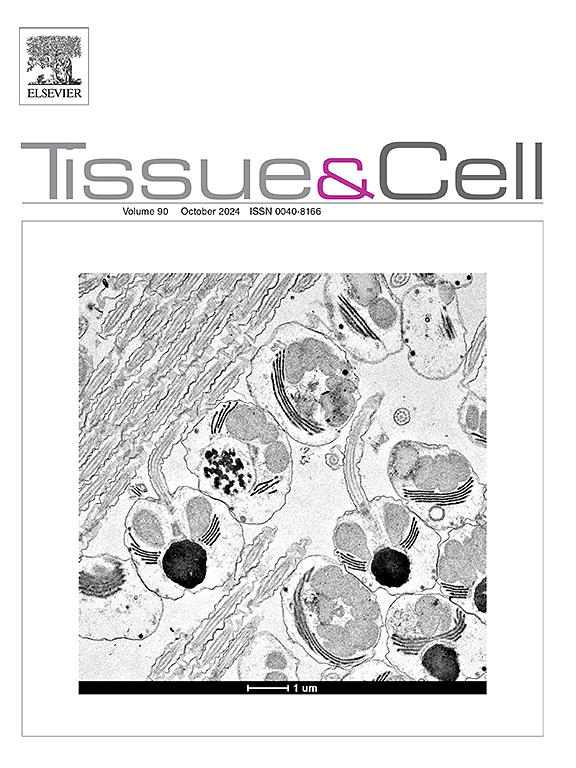Testicular injuries from 45 min of renal ischemia after 24 and 48 h of reperfusion
IF 2.7
4区 生物学
Q1 ANATOMY & MORPHOLOGY
引用次数: 0
Abstract
Ischemia/reperfusion (I/R)-induced acute renal failure (ARF) is linked to oxidative stress and inflammation, which can adversely affect other organs. The degree of injury and subsequent recovery in these organs is determined by the expression of specific molecules during reperfusion, as well as the ischemia's severity and duration. This study investigated how varying durations of reperfusion impact testicular function and sperm characteristics, including count and morphology, after ischemic acute renal failure in male rats. Male Sprague-Dawley rats (n = 7 per group) were divided into three groups: a sham group without renal artery occlusion and two ischemia/reperfusion (I/R) groups subjected to 45 min of bilateral, followed by reperfusion for either 24 h (I/R-24h) or 48 h (I/R-48h). Blood samples were analyzed for plasma levels of creatinine, blood urea nitrogen, testosterone, luteinizing hormone, and follicle-stimulating hormone. Following deep anesthesia, the left testis and kidney were excised for histopathological evaluation and malondialdehyde level measurement. Results showed that 24 h of reperfusion after 45 min of ischemia elevated plasma creatinine and BUN levels, decreased testosterone, and increased levels of inflammatory markers (TLR4, NFĸB, TNF-α) in testis tissue. However, sperm count and morphology remained unchanged. Extending the reperfusion to 48 h mitigated these effects, suggesting that prolonged reperfusion reduces oxidative stress and inflammation, thereby alleviating testicular damage.
肾缺血45 min后再灌注24和48 h睾丸损伤
缺血/再灌注(I/R)诱导的急性肾功能衰竭(ARF)与氧化应激和炎症有关,可对其他器官产生不利影响。这些器官的损伤程度和随后的恢复取决于再灌注时特定分子的表达,以及缺血的严重程度和持续时间。本研究探讨了雄性大鼠缺血性急性肾功能衰竭后不同时间再灌注对睾丸功能和精子特征(包括数量和形态)的影响。雄性Sprague-Dawley大鼠(每组 = 7只)分为三组:无肾动脉闭塞假手术组和双侧缺血/再灌注组(I/R-48h) 45 min,再灌注24 h (I/R-24h)或48 h (I/R-48h)。分析血液样本的血浆肌酐、尿素氮、睾酮、促黄体生成素和促卵泡激素水平。深度麻醉后,切除左睾丸和左肾进行组织病理学评估和丙二醛水平测定。结果显示,缺血45 min再灌注24 h后,血浆肌酐、BUN水平升高,睾酮水平降低,睾丸组织炎症标志物TLR4、NFĸB、TNF-α水平升高。然而,精子数量和形态保持不变。延长再灌注至48 h可减轻这些影响,表明延长再灌注可减少氧化应激和炎症,从而减轻睾丸损伤。
本文章由计算机程序翻译,如有差异,请以英文原文为准。
求助全文
约1分钟内获得全文
求助全文
来源期刊

Tissue & cell
医学-解剖学与形态学
CiteScore
3.90
自引率
0.00%
发文量
234
期刊介绍:
Tissue and Cell is devoted to original research on the organization of cells, subcellular and extracellular components at all levels, including the grouping and interrelations of cells in tissues and organs. The journal encourages submission of ultrastructural studies that provide novel insights into structure, function and physiology of cells and tissues, in health and disease. Bioengineering and stem cells studies focused on the description of morphological and/or histological data are also welcomed.
Studies investigating the effect of compounds and/or substances on structure of cells and tissues are generally outside the scope of this journal. For consideration, studies should contain a clear rationale on the use of (a) given substance(s), have a compelling morphological and structural focus and present novel incremental findings from previous literature.
 求助内容:
求助内容: 应助结果提醒方式:
应助结果提醒方式:


